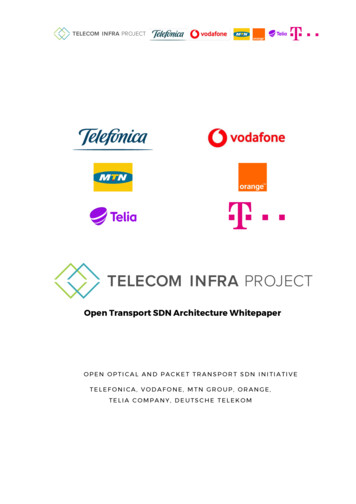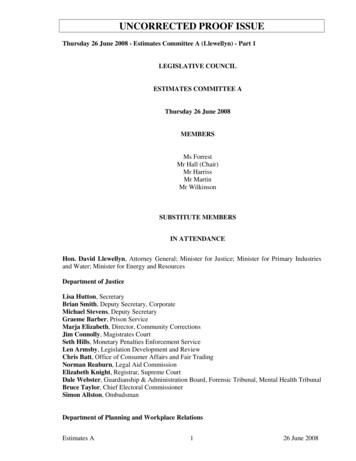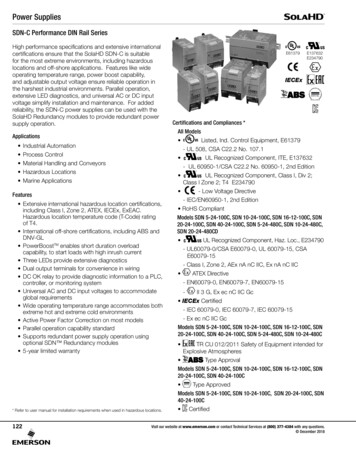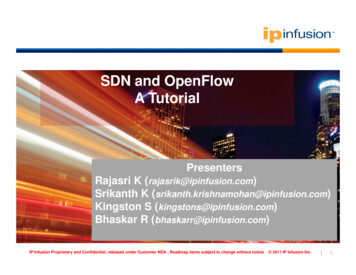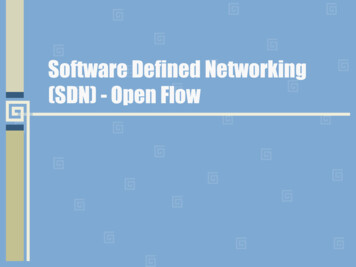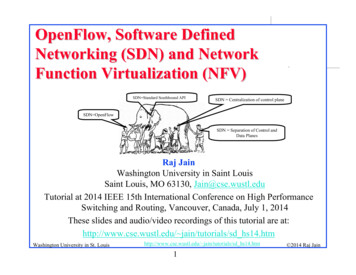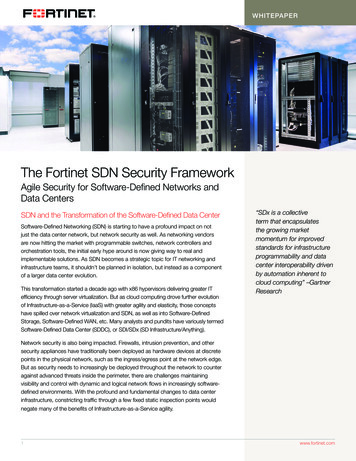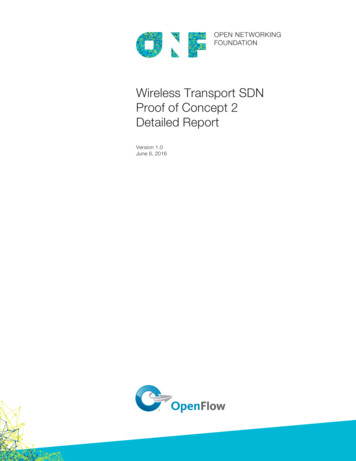
Transcription
Wireless Transport SDNProof of Concept 2Detailed ReportVersion 1.0June 6, 2016
Wireless Transport SDN PoC White PaperVersion No. 1.0ONF Document Type: White PaperONF Document Name: Wireless Transport SDN PoC White PaperDisclaimerTHIS SPECIFICATION IS PROVIDED “AS IS” WITH NO WARRANTIESWHATSOEVER, INCLUDING ANY WARRANTY OF MERCHANTABILITY,NONINFRINGEMENT, FITNESS FOR ANY PARTICULAR PURPOSE, ORANY WARRANTY OTHERWISE ARISING OUT OF ANY PROPOSAL,SPECIFICATION OR SAMPLE.Any marks and brands contained herein are the property of their respective owners.Open Networking Foundation2275 E. Bayshore Road, Suite 103, Palo Alto, CA 94303www.opennetworking.org 2014 Open Networking Foundation. All rights reserved.Open Networking Foundation, the ONF symbol, and OpenFlow are registered trademarks of theOpen Networking Foundation, in the United States and/or in other countries. All other brands,products, or service names are or may be trademarks or service marks of, and are used to identify,products or services of their respective owners.Page 2 of 33 Open Networking Foundation
Wireless Transport SDN PoC White PaperVersion No. 1.0Table of ContentsExecutive Summary . 51Introduction . 52SDN Network Architecture and Configuration . 62.1 Overview . 62.2 PoC Test Network Setup . 73Use Cases and Applications . 84Test Results . 95Conclusions . 106Contributions . tional Model. 11UML Information Model. 12YANG Data Model . 14Evaluation of Open Source Netconf Servers . 15Basis Mediator . 16Default Value Mediator . 18Element Auto Detection . 19UI for Showing and Configuring Parameters . 21Application for Showing Aberrances . 23GUI for Showing the Configured Network . 25GUI for Showing the Effective Network. 28Event Handling. 29Testing Framework . 31References . 33List of FiguresFigure 1: Overview of the SDN Architecture used in the 2nd Wireless Transport PoC . 6Figure 2: SDN Test Network Configuration using Virtual Machines . 8Figure 3: Example Functional Model for plain Microwave Link . 12Figure 4: Main Elements of the Microwave Model . 13Figure 5: Example of a Pac . 13Figure 6: Basic Mediator . 16Page 3 of 33 Open Networking Foundation
Wireless Transport SDN PoC White PaperVersion No. 1.0Figure 7: netconfd Server (from open Yuma user manual) . 17Figure 8: Tools of OpenYuma (from open Yuma user manual) . 18Figure 9: Mediator Discovery Sequence of Operations . 21Figure 10: Configuration GUI . 23Figure 11: Path from Planning to Actual Object . 24Figure 12: Aberrances User Interface . 25Figure 13: Configured Network GUI . 27Figure 14: Explanation of Configured Network GUI . 27Figure 15: Effective Network GUI . 28Figure 16: Event Handling in OpenDaylight . 30Figure 17: Testing Framework Architecture . 32Page 4 of 33 Open Networking Foundation
Wireless Transport SDN PoC White PaperVersion No. 1.0Executive SummaryThis white paper provides an overview of a significant technical Proof of Concept (PoC) projectconducted from 25th to 28th of April 2016 by the Wireless Transport Project of the OpenNetworking Foundation (ONF) in Munich, Germany.This PoC focused on demonstrating the capabilities and benefits of utilizing a commonInformation Model for multi-vendor control of wireless network elements through openmanagement interfaces.The PoC included wide participation from the wireless transport industry including operatorrepresentatives, microwave equipment vendors, integrators and applications providers.Five uses cases are included in this PoC to demonstrate wireless transport SDN applicationsillustrating topology planning and discovery, with dynamic view in real time, configuration,discrepancy monitoring and detection, and event handing.The following 5 use cases are implemented and are the subject of this PoC for the purpose ofdemonstrating the aforementioned applications and presented in this whitepaper: Detection and configuration of new microwave devicesDetection of aberrancesDetection and Visualization of the configured microwave networkDetection and Visualization of the currently effective networkReceiving, displaying and storing of alarm informationA standard OpenDaylight (ODL) version was used as the SDN controller. Mediators were usedfor translating the information model to vendor specific configurations.All vendors implemented the model and completed all the test cases successfully demonstratingthe viability of the concept for using a common information model for configuring andmanagement of wireless network elements using open management interfaces.1 IntroductionThe core element of the 2nd wireless transport PoC is to prove the effectiveness of an SDNwireless transport modeling in a multivendor radio transport network.The 2nd wireless transport PoC is an evolution of the 1st one, emphasizing the relevance of acommon information model being developed in ONF by the Wireless Transport Project. Theintended use cases leverage on the information model to offer a common and stable frameworkfor multi-vendor control of wireless network elements through open management interfaces likeNetconf.This incremental step aims to demonstrate advantages in the operation of wireless transportnetworks incorporating such open capabilities, and show the facility of integration andcooperation with other parts of the network.The 2nd wireless transport PoC took place from 25th to 28th of April 2016 and was hosted byTelefónica Germany in their laboratory in Munich Germany.Page 5 of 33 Open Networking Foundation
Wireless Transport SDN PoC White PaperVersion No. 1.0The PoC was supported by wide representatives from the wireless transport eco system includingoperators, manufacturers, integrators and applications providers. In particular, the followingcompanies supported the PoC: The following Vendors participated in the PoC with their microwave equipment:Ceragon, Ericsson, Huawei, NEC and SIAE The following Integrators and Application Providers provided buildings block andapplications:HCL, highstreet technologies, Tech Mahindra and Wipro Content and organizational support for the PoC was provided by the following Operators:AT&T, Deutsche Telekom and Telefónica (Telefonica Germany 1 and TelefónicaI D/Telefónica Global CTO2)Moreover, Viavi provided measurement devices and configuration support.2 SDN Network Architecture and Configuration2.1OverviewThe SDN architecture and configuration of the test setup in the 2nd Wireless Transport PoC isillustrated in Figure 1 below.Figure 1: Overview of the SDN Architecture used in the 2nd Wireless Transport PoC12As host and provider of lab facilities and logisticsAs part of the 5G-Crosshaul project (grant no. 671598 of EU H2020 program; www.5g-crosshaul.eu)Page 6 of 33 Open Networking Foundation
Wireless Transport SDN PoC White PaperVersion No. 1.0The architecture identifies the main objects which are target of implementation and subsequentverification: The ODL controller, the mediators, the Netconf interface and the northboundapplications.The network deployment includes a single SDN controller, an application layer whichimplements specific functions that are intended to operate over the network via northboundinterfaces and a wireless network layer. The wireless network layer is composed of pairs ofdevices and mediators and interoperates with the controller via Netconf. The mediators aredevices specific and proprietary to the vendors.The developed functional information model is incorporated into OpenDaylight viaNetconf/YANG plugins able to populate the MD-SAL data store. The OpenDaylight has been object of implementation to allow up streamed messageexchange Further packages have been implemented atop the ODL DLUX GUI bundle Microwave applications can be installed and run on top of the extended OpenDaylightSDN controller with the microwave pluginsA testing framework has been also developed for end-to-end solution verification in a continuousintegration perspective.Netconf has been chosen over OpenFlow as a protocol for configuration and management of themicrowave devices for several reasons. It is by design a general-purpose management protocol,while OpenFlow is primarily intended for operating the traffic forwarding plane of the device(e.g. traffic flows). Also, YANG can be used to implement the data model for Netconf, comingto a representation of a clearer and more readable information model. Instead of implementingNetconf protocol handlers in the devices, some external mediators (adapters) were used fortranslating the Netconf/YANG microwave information model to/from the existing proprietarymanagement protocols of each vendor’s devices. This approach allowed: being more flexiblesaving time in the development and the debugging phasesharing code between PoC participantsIn addition to the mediators required to connect the physical NEs, an NE simulator (“DefaultValues Mediator”) has been developed. It behaves like a generic NE, which allows redemonstrating the use cases and applications from the PoC without the actual need andinstallation of physical microwave equipment. This supports Telefonica’s plans on maintaining aserver running a demonstration and testing environment for future application developments.2.2PoC Test Network SetupThe SDN network of the PoC is implemented using Virtual Machines (VM) for the core SDNcontroller – including some management applications – external applications, and for themediators used by each vendor for integrating into their hardware. The network configurationwith the VM is shown in Figure 2.Page 7 of 33 Open Networking Foundation
Wireless Transport SDN PoC White PaperVersion No. 1.0Figure 2: SDN Test Network Configuration using Virtual Machines3 Use Cases and ApplicationsThe following use cases are implemented for the purpose of demonstrating dynamic networkview, configuration, discrepancy monitoring and detection, and event handing: Detection and configuration of new microwave devicesDetection of aberrancesDetection and Visualization of the configured microwave networkDetection and Visualization of the currently effective networkReceiving, displaying and storing of alarm informationBrief description of each use case is provided in the subsections below.Detection and configuration of new microwave devicesThis use case is used to demonstrate the capability of the SDN controller in detecting andconfiguring new network elements (NE) when introduced and deployed into the network. TheController is used to collect information from the new NE and provide up-to-date informationabout the network. It achieves this by automatically identifying new elements added to thenetwork and displaying current element configurations. The use case also demonstrates thecapability of manually configuring a NE.Detection of aberrancesThis use case illustrates the Controller and its corresponding Application the capability ofcomparing the actual network configuration with external reference data such as the plannedconfiguring for an NE. The controller can then identify discrepancies between the planned andPage 8 of 33 Open Networking Foundation
Wireless Transport SDN PoC White PaperVersion No. 1.0current configurations and present the network operator with corrections, which can then beconfirmed and executed into the network.Detection and Visualization of the configured microwave networkThis use case relates to demonstrating the capability of the Controller and its Application indetecting the installed and deployed NEs and display the desired underlying wireless transportnetwork topology then calculate and configure the capacity information for each NE based on theprovided configuration information. The controller can then display the configured topology andrelated capacity information of the network at each microwave link.Detection and Visualization of the currently effective networkThis use case demonstrates the capability of the controller to detect the effective networktopology, the installed and active NEs, and their corresponding effective capacity. It alsodemonstrates application for which the controller can detect and display deviations from theplanned and configured network to the actually current network status.Receiving, displaying and storing of alarm informationThis last use case is introduced in the PoC to demonstrate the capabilities of the Controller inhandling alarms and events from the network. This is demonstrated by storing and displayingevents information when they occur. The information used in the PoC for each event includesNE IDs, type of problem, severity identifier and timestamp.4 Test ResultsFive wireless transport vendors and four integrators/application providers participatedsuccessfully in the test. The tests were done with an OpenDaylight (Lithium SR4) SDNcontroller. Additional functions required for the PoC use cases were provided by various SDNapplications which had been implemented for the PoC and integrated into the SDN controller: Topology ApplicationComparison ApplicationConfiguration ApplicationEvent Handling ApplicationNE Discovery applicationThe same south bound interface (Netconf protocol and YANG data models) was used betweenthe OpenDaylight controller and the mediators from different vendors. The interfaces betweenmediators and network elements were proprietary interfaces which were not included for testingin this PoC.The five use cases explained in section 3 were successfully tested by performing the followingsteps for the network elements of each vendor.After having been started, the mediators announced their network elements to the Controllerthrough the NE Discovery Application. The network elements became visible at the ControllerGUI. The Topology Application displayed the configured capacity of all radio links in agraphical representation of the PoC network. The Comparison Application showed the plannedPage 9 of 33 Open Networking Foundation
Wireless Transport SDN PoC White PaperVersion No. 1.0and actual values of all microwave attributes and highlighted the discrepancies. For the purposeof the PoC discrepancies were provoked by giving “wrong” planned values.The configuration of the network elements was then modified by using the ConfigurationApplication: either the transmitter of one link was switched off or the transmission power wasreduced. As a consequence the affected link provided less or no capacity and the overall capacityof the network was reduced. This effect could be seen both in the Topology Application and atthe GUI of the traffic analyzer. The original capacity was restored as soon as the respectiveconfiguration was reverted to the initial values.The configuration changes also triggered the network elements to report events which wereforwarded as Netconf notifications to the Controller. The Event Handling Application was usedto display these notifications.5 ConclusionsOperatorsThis Second PoC has been proved to be a significant step towards the generalization of acommon Information Model for SDN-enabled Wireless Transport environments, simplifying theoperations and control of these network elements, and facilitating the integration of distinctmulti-vendor solutions under a common and single control framework.It has been demonstrated a unified control and management of five wireless transport vendorproducts (Ceragon, Ericsson, Huawei, NEC, SIAE) implementing the same Information Model(being defined in the context of ONF by the Wireless Transport project, with the participation ofthose major manufacturers), in an open environment with an OpenDaylight based controller.VendorsThe PoC has demonstrated how it’s possible to cooperate to provide a multi-vendor microwavenetwork managed by a single SDN controller. This offers the possibility to operators fordeveloping their own applications on top of an open and modern REST northbound interface,independently from the vendors providing the microwave
Wireless Transport SDN Pr
